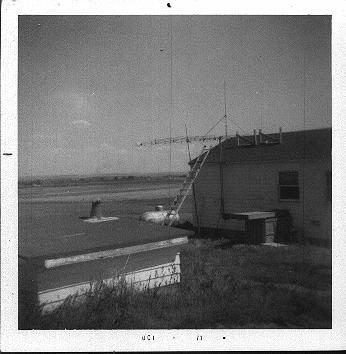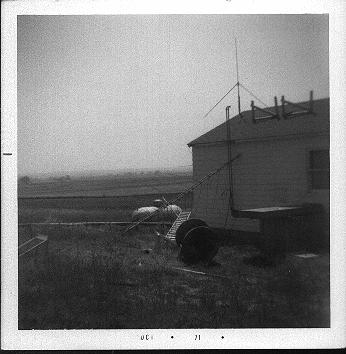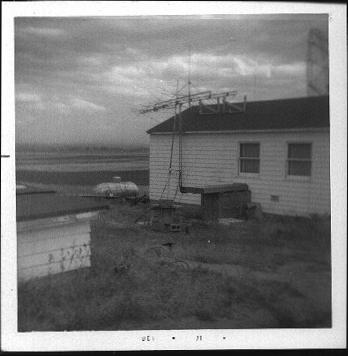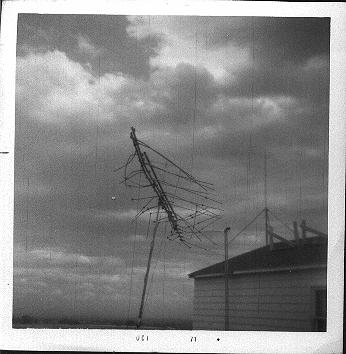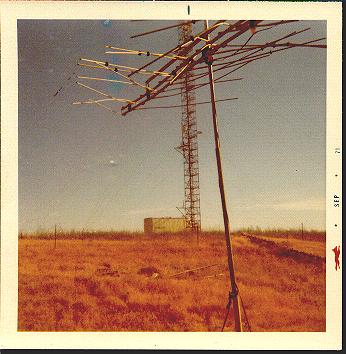The progressive demise of a 19-element log periodic hi-low VHF TV antenna at the DoC Gunbarrel Hill Field Site near Boulder, Colorado in Jul-Sep 1971.
late Jul 1971 This antenna (with c. 204" boom) was found onsite folded up under a nearby storage trailer unit. Suitable masting material was then located in a pile of such items maybe 1000' away - which required electric drill work and hardware to fabricate a long enough piece. OK, it's a JFD model LPV-TV190 as seen at the bottom of Page 391 in the 1970 Allied Radio Catalog found here. I seem to have mounted it upside down there with regards to the boom brace! The first install was made at the n.e. corner of the building, but its rotation was impeded by that ground-plane antenna (which was for an unused crystal controlled 41-MHz transceiver there). Attempts were made to remove the g.p., but it was determined to be too risky to try it alone (a large 220-v window air conditioner was located high up along the east side of the building under it). During a thunderstorm the unfixed base of the mast of the TV antenna became dislodged, and its top pivoted well towards that partially-filled propane storage tank (for a floor furnace), making for another impetus to move it to a "safer" location! There are other noteworthy items in this image. The nearest low-profile structure is the housing for the well pump. However, the sewage from there had seeped into the well water making its use rather limited at best! The remnants of some microwave dish supports are on the roof as well as part of their wave guide feed plumbing jutting from the north side of the building. On the southside were the storage structures for the automated carbon dioxide fire extinguisher system (put in after another field site building had burnt down while unattended) seen here.
early August 1971 A large empty wooden cable spool was located near the base of the 120' tower onsite, some 400' n.n.e. of the building. It was decided that this could serve as the new base anchor for that TV antenna. It was sent rolling downhill and luckily turned over and stopped before striking the building! It was weighed down with some cinder blocks (too few, as can be seen above) to resist the prairie winds. I arrived back there to find that the non-storm winds had won out. These were not the infamous Chinooks, which Boulder mostly suffers at a different time of the year and are usually well spent by the time that they reach this far out east of the Rockies. That is the cable raceway to the tower just this side of the propane tank.
Sept 8, 1971 More cinder blocks added to the wooden cable spool to prevent future overtipping by the winds (not completely successfull though).
Sept 8, 1971 A close up of the damaged antenna. Ignoring the vertical film emulsion scratches, if you carefully look you can see at least one string/rope restraint added to the boom to prevent it from windmilling. The Es season and the Perseids were well over.
Aug 1971 An earlier Instamatic color shot (perhaps taken from the building window) showing less damage. The 300-ohm twin lead is wrapped along the mast. The 120' tower (with its internal walk-up stairway that I never dared to try) base is c. 400' away. The van there was part of a Raman spectroscopy project using a sodium-light laser that was started while I was there*. One of the guys involved with that did climb up to change out the non-flashing aviation warning light at the tower top when it burned out (I'd left a memo with site manager Steve Barnes** who notified the FAA, etc.) The side arms on the tower had housed various instruments at one time or another.
* They used electric power from the building, which due to current limitations (blown cartridge fuses) required that the large air conditioner be turned off when they were active. Luckily, most of that was when I wasn't there or at night when it was cooler. One time I arrived there and found the unit off and asked them "How long ?" It turned out that they weren't using any power - the air conditioner had blown the high-amperage fuse on its own! ** I visited his QTH in Boulder once where he had momentos of his Pacific and Antarctic adventures, including a coconut crab on the wall (which species could snap a broomstick with its claws).
Page created Nov 13, 2013
